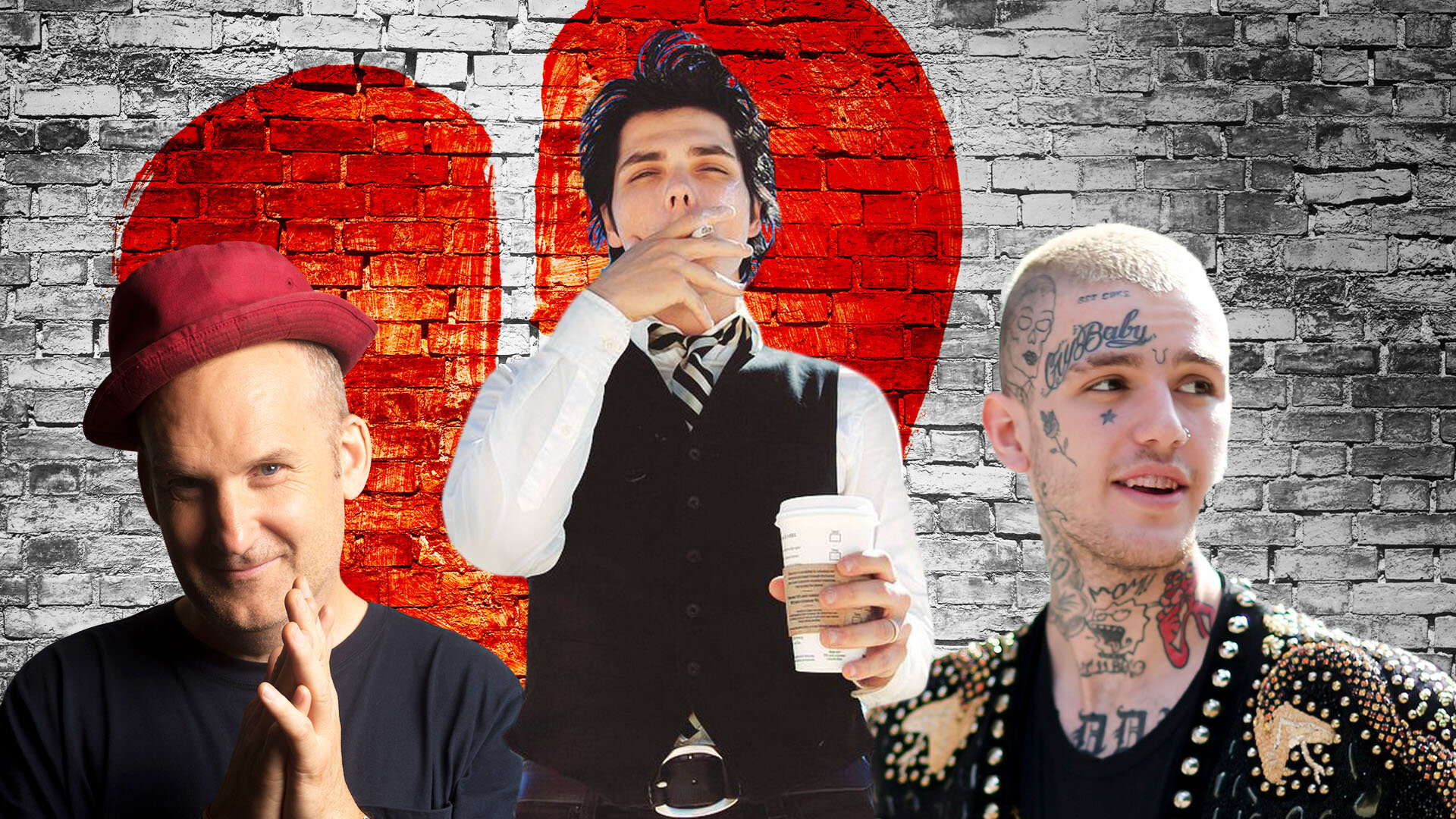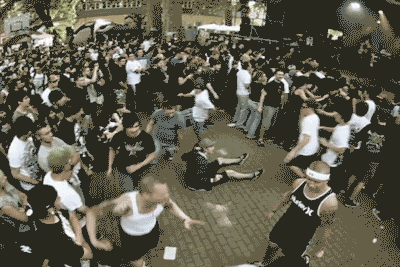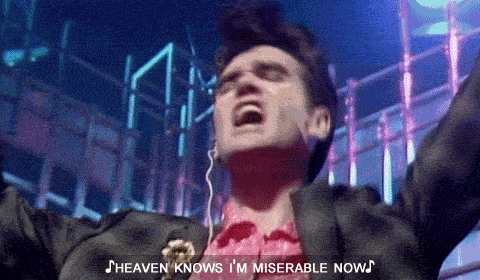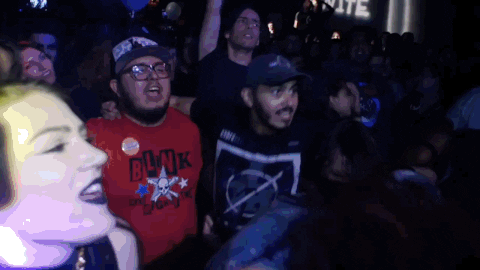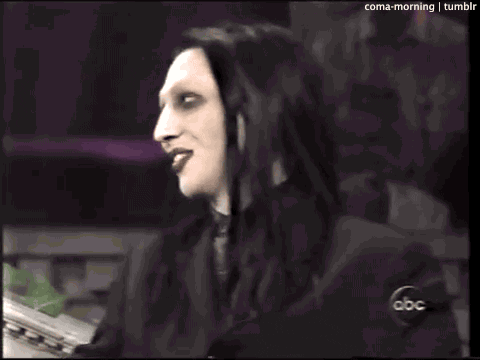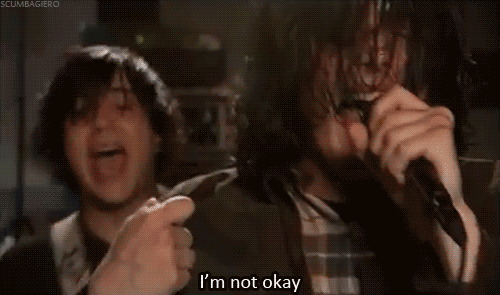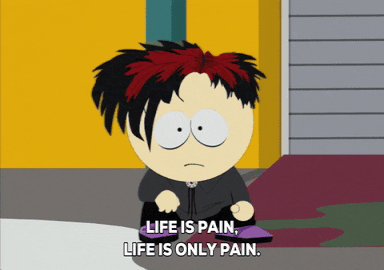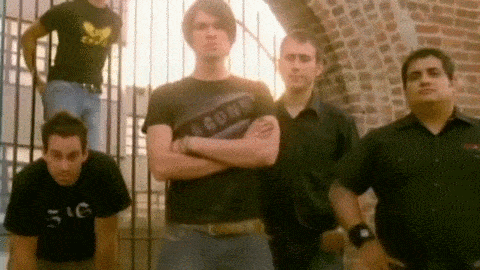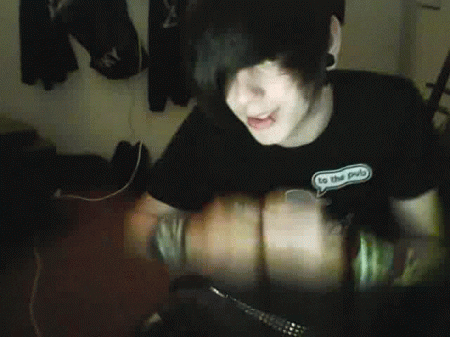The Outsider's Guide to Emo
* Follow me on: Facebook - Twitter - Instagram *
Don’t get emo on me, bro.
I heard that phrase for the first time in my life around 2001 or so. I didn’t give it much thought at first. It seemed like the hip new way of saying the word “emotional” and hip new way of saying things were always spoken into existence faster than I could notice them. The only things I cared about then were mixed martial arts, masturbation, internet forums, Iron Maiden and that girl who wouldn’t give me the time of day.
But then I started noticing it: a weird virus that started infecting every pop punk band on television. They started dying their hair black, wearing egregious amounts of eyeliner and their song lyrics were suddenly imbued with an emotional urgency that came out of nowhere. Green Day, Sum 41, Blink 182, they were all doing it. Going from Geek Stink Breath to Boulevard of Broken Dreams felt like a reach, but no one seemed to notice. No one seemed to give a shit.
That was my introduction to emo. Of course, My Chemical Romance, Simple Plan, Fall Out Boy, Panic! At The Disco and the others followed suit. Before I knew it, there was a new scene taking over popular culture. One I didn’t relate to and who’s popularity seemed to marginalize my own taste and values. So, I condescendingly dismissed emo like so many metalheads who were angry mainstream culture didn’t cater to their needs anymore. It was a fad. It was potentially harmful to kids who fetishized emotions they weren’t mature enough to understand.
It took me years to realize that I was full of shit. That I was looking at a fragmented reflection of a bigger, more complex cultural phenomenon that was eluding me. What you’re going to read today is the outcome of a fifteen years cultural reassessment process that began with the discovery of Henry Rollins’ angry letters on YouTube in 2007 or so. Without Rollins, I would’ve never known who Ian MacKaye is and much less taken interest in his recording career past his Minor Threat days.
What you’re going to read is a guide to understanding what emo is musically and culturally meant for people who do NOT get it, but who are curious and willing enough to learn from one of their peers. Because learning from the internet doesn’t feel like learning at all, am I right? All these years, we’ve had emo wrong. The word itself doesn’t mean what it should mean. This is the story of a cultural drift and how things end up drifting in culture. This is the outsider’s guide to emo.
Part 1 : Revolution Summer and the inception of post-hardcore
There’s a clear starting point to our journey: the original emo music scene was born in Washington D.C in 1984, when the band Rites of Spring was formed. They were not exactly trying to invent a new genre, like Black Sabbath were not exactly trying to invent heavy metal when they did. They were kids from the D.C hardcore punk scene who were trying something new. No one knows who exactly coined the term emo or when it started being used, but everybody fucking hated it.
“I've never recognized ‘emo’ as a genre of music. I always thought it was the most retarded term ever,” said frontman Guy Picciotto in 2003. According to him, the emotional nature of Rites of Springs’ lyrics were the byproduct of his youthful intensity. “I decided to sing and that's what came out. Because when I was young, I was nuts.”
But Rites of Spring was new and exciting. They had a groundbreaking sound and groundbreaking ideas. It was a question of time before someone would put a label on it. Back then it was called emocore, which basically meant hardcore punk with emotional lyrics. That didn’t quite make sense to Picciotto : “What, like the Bad Brains weren't emotional? What - they were robots or something?” he said, in the same interview.
Picciotto is somewhat right. Rites of Spring had more going for themselves than lyrical themes. They were more melodic, experimental and most important : willing to break the rules set by the oddly conformist punk rock scene at large. “There was a situation where the shows were becoming increasingly, moronically violent,” said the owner of Dischord records Ian MacKaye, who would go on to form the iconic post-hardcore outfit Fugazi with two members of Rites of Spring. “A lot of people were like: 'fuck it, I'll drop out, I don't want to be a part of this any more.”
Picciotto, MacKaye and many other important figures of the D.C hardcore punk scene were taking a stand against the violence, sexism, politics and creative stasis surrounding their way of life. They were tired of being perceived as soulless, destructive idiots and decided to launch a movement called Revolution Summer. It is the main reason why Rites of Spring, Embrace and other early emocore bands became influential enough to shape the future of commercial music.
“It was our summer of love,” said a musician friend of mine.
Originally devised by D.C punk Amy Pickering, the Revolution Summer activists started sending ransom notes promoting their values to local bands and important people of the scene. A band like Rites of Spring was instrumental to broadcasting their message, because it stood against the image of monolithic aggression and violence the D.C hardcore punk scene was known for then. It was more than just about the music. Rites of Spring were the face of a paradigm shift in the D.C hardcore punk scene. They were a symbol of openness, inclusion and empowerment.
What does it have to do with their emocore aesthetic?
This is a good question, but I do think there’s a fairly straightforward answer. Rites of Spring, Embrace and Dag Nasty were kids from the D.C hardcore punk scene who deliberately chose to move on. They let go of the destructive anger and made the conscious decision of writing lyrics that showed vulnerability and sometimes even distress. They were tough-guy musicians who consciously told their peers: “fuck you, this is stupid. We’re going to do something else.” That idea alone spoke to marginals who related to punk rock’s energy and self-awareness, but didn’t share the anger. It was technically not the birth of post-hardcore music, but Revolution Summer and emocore were major catalysts of its rise in popularity.
If you listen to Rites of Spring and Embrace today, you’ll notice it sounds a lot more like Quicksand or At the Drive-In than My Chemical Romance. It was fueled by the fire of hardcore, but shaped by the life-affirming creativity of people who were 100% emotionally involved in their art. The early emocore scene has little to do with what the scene sounds like today, but it has everything to do with why its values resonated and reverberated into the future.
Rites of Spring and Embrace broke up in 1986. They went on to form Fugazi, one of the biggest and most respected post-hardcore band of all-tme. None of them ever wanted to be associated with emo, so it would’ve been the end of that, except….
Goth Interlude 1
Across the Atlantic Ocean, there was another musical revolution taking place. By all means, post-punk greatly influenced the inception of post-hardcore by merely showing there were more possibilities if you decided to bend the rules a little. One of the most important bands from the post-punk British scenes was The Smiths. What made them extremely popular and pertinent to our sweeping cultural history today is that they wrote lyrics that felt… well, take a look for yourself:
I am the son
and the heir
of a shyness that is criminally vulgar
I am the son and heir
of nothing in particular
You shut your mouth
how can you say
I go about things the wrong way
I am human and I need to be loved
just like everybody else does
(from How Soon is Now?)
That sounds… kind of emo, doesn’t it? History particularly wasn’t kind to The Smiths. Those who remember they ever existed (critics and self-loathing music nerds) can’t take them seriously now, because their singer Morissey is a right wing nut. Your politics might not have anything to do with your art, but they will make your juvenile, melodramatic poetry seem less charming in retrospect. Anyway, keep them in mind. Because they have influenced what’s about to come. I mean look at these lyrics. They speak for themselves. If late-era emo sounds whinier, it’s partly because of them.
While I do not like The Smiths myself, there are people who thought their theatrical and melodramatic lyrics were pretty fucking cool and profound. They were a hit with Goth kids in the eighties and they definitely had an influence on 90s rock songwriting in general. Before them, no one was quite as disarmingly up front about their melancholy and alienation.
I’m not judging! I had In the End by Linkin Park in workout playlists for two decades now.
Part 2: Second wave of American emo
The music industry was not out of revolutions after the summer of 85. You might be familiar with another paradigm shifting musical genre called grunge? Well, grunge doesn’t have anything in common with emo except for one thing: it is influenced by the punk scene of the eighties. What it has done for emo, though, is create a brand new genre called alternative rock, which will be foundational for the new breed of emo. You might’ve heard of it too.
But I’m getting ahead of myself here.
Original emocore might’ve died out, but it didn’t stop the music (and the groundbreaking ideas attached) from traveling across the U.S. It made a stop in New York City where Blake Schwarzenbach and Adam Pfahler founded Jawbreaker, a fully assumed skate punk band with one important caveat: Schwarzenbach used his own journals for lyrical inspiration, giving the often upbeat songs an almost confessional-like intimacy. Then, the emo train progressed along to the West Coast, where a very different kind of band was formed: Sunny Day Real Estate.
Although Blake Schwarzenbach’s lyrics trace a direct lineage to Rites of Spring and British Goth rock acts, it’s the other band that interest me. Sunny Day Real Estate was different. They were not a punk rock band. They came a little later in the game and didn’t officially release an album until 1994, but their debut Diary was an absolute game changer. Not only it dialed down on the punk rock aesthetic and aggression, but it really was the first time emo sensibility reached the mainstream (or close to it anyway). They performed on The John Stewart Show and on MTV’s 120 Minutes, which means they could reach lots of kids that never heard of emo.
The band has a weird history, which includes having their bassman Nate Mendel and their drummer William Goldsmith literally poached by Foo Fighters (Goldsmith quit soon after because of Dave Grohl’s insanely high standards for drumming) and the band never quite broke out like it should’ve, but their work was already done. A wave of nerdier, more thoughtful and reflective emo bands who married musical experimentation and progressive sensibilities with the rawness and emotional emergency of emo.
It was the birth of what is known today as Midwest Emo.
There’s a lot of people who mix up second wave emo and midwest emo, because the latter takes a notably important place at the heart of the former. If Jawbreaker and Sunny Day Real Estate restarted the fire, what would ensue was a fucking infero of new bands and the birth of an important emo stereotype: the sensitive, bespectacled kid wearing flannel shirts and ear stretches, singing and crying his heart out at show. These guys were midwest emo kids.
Standout bands from this era were The Promise Ring, Jimmy Eat World (blast from the past, huh?), The Get Up Kids, Cap’n Jazz, Braid and ...fuck, I don’t know all that many midwest emo bands. My favorite though are American Football, who emerged a little later from the ashes of Cap’n’ Jazz (1999). They were basically an indie rock band with very dramatic lyrics about breakups, fuck ups, mistakes and apologies that were written in a more adult, subdued way. They had an emotional sophistication and a depth other didn’t quite match.
This sonically friendlier approach in the midst of alternative rock heyday made emo commercially intriguing for bigger labels and bigger labels came sniffing around. Jimmy Eat World gained some exposure via the movie soundtrack of Never Been Kissed, The Get Up Kids were opening for Weezer (who were retroactively declared to be emo, which is the most Weezer thing to ever happen), even Blink 182 started fiddling with emo on Adam’s Song. The interior life and distress of teenagers was about to go nuclear and it was both great and depressing that it even happened.
Ultimately, the worldwide explosion of pop punk emo is how many have discovered the genre, so I guess it was a necessary thing to happen in hindsight.
Goth Interlude 2
There was another big cultural phenomenon raging in the U.S in the late nineties-early 00’s and his name was Marilyn Manson. Now, Manson did not outwardly influence emo. But he greatly influenced fashion. Notably with the idea that how you dress should be a reflection of how you feel. Manson felt like a Dionysian creature most of the time, so he dressed accordingly. But, the outer darkness that reflected inner darkness (which is really a Goth thing if you ask me) was rendered mainstream by him. He was transforming cute, polite kids into little devils and he loved it.
I really doubt there would’ve been such a powerful emo aesthetic (the long, dark hair, makeup,etc.) without Marilyn Manson. The world wouldn’t have been ready. It wouldn’t have been ready for themes of loneliness and alienation addressed in such an urgent and straightforward way either. You might not remember, but the world was a different place then. The internet was in its infancy and we weren’t exactly used to seeing horrible shit on a daily basis. You had no vegan cousin to show you photos of butchered animals whenever you went online, because Facebook didn’t exist.
Anyway, a toning down of the punk rock aesthetic, influences from Goth culture and old media trying to capitalize on the coming of age of troubled teenagers lead us here.
Part 3 : The My Chemical Romance years
So, do you see how we got here? What was first an act of rebellion against the self-destructive culture of hardcore punk meant to show people were vulnerable and multifaceted was turned in fifteen years or so into a series of product sold to kids in order to symbolize their inner turmoil. You did not need black clothes, eyeliner and a windswept haircut to have emotional troubles, but everybody would suspect you had emotional troubles if you wore the right clothes and listened to the right bands.
The no. 1 band that symbolized this era to me is My Chemical Romance. Simple Plan probably sold more records, but they were not taken as seriously (especially when they kicked into full blow emo overdrive). Bands like Green Day and Weezer clinged to the aesthetic, but they were merely trying to imitate what worked then. They had success with a much older audience, who was already into what they were doing anyway. The kids at large (who are the authority on all things rock n’ roll) loved the new bands: Fall Out Boy, Panic! At the Disco, Paramore and most important: My Chemical Romance.
What made My Chemical Romance so important exactly? Glad you asked. Well, they were formed after a tragedy. Frontman Gerard Way explained in press conference once that he decided to form a band soon after 9/11 because it was a secret dream of his and now he knew that it could be unfairly taken away at any moment. That’s major dramatical cred right there. By the way, there is a My Chemical Romance song called Skylines & Turnstiles that’s about 9/11 if you’re curious.
Secondly, they were doing something new and they were great at it. They were not a pop punk band that decided to darken up because it was cool to do so, like Simple Plan * did. They played a hybrid of pop punk and alternative rock that really blended well together. They were lyrically ambitious and while they did plenty of wallowing, they were not doing JUST that. These guys told stories with breath and scope. Melodramatic fantasies upon which kids could project themselves. These guys were 2.0. In the immortal words of Marilyn Manson, they were the new shit.
Although My Chemical Romance clearly operated within the fantasy realm with concept albums and hyperrealities, but they had an air of seriousness about them. They were committed to their art. Bands like Panic! At the Disco and Fall Out Boy also were, but they also looked semi-normal people who looked like they were having fun being rock stars. Gerard Way and his musicians were characters.They brought you to another world. For some reason, they remind me of classic rock band Queen with their operatic ambition.
That was the thing with My Chemical Romance: they were inimitable. I was discussing with lifelong emo fans in the Facebook group Midwest Emoposting and a great majority of them became fans in this era. Bands like My Chemical Romance, Fall Out Boy, Taking Back Sunday, Dashboard Confessional, Jimmy Eat World and Hawthorne Heights are often mentioned. Not one of them mentioned Simple Plan. All these bands seemed silly to me then, but who knows what my opinion would’ve been if they were my first contact with marginal culture. I was a dreamy, wide-eyed kid kid trapped in a rough place with rough people with no real exit in sight. Aggression became a language to me because of metal, but who would’ve known if I was born ten years later?
I’m intentionally forgetting plenty of bands in this section because we’ve lived through this era together and still remember who was popular then. A couple named I could mention: The Red Jumpsuit Apparatus, AFI, The Used, Rise Against, Alexisonfire, etc. It was a weird era that both bastardized what emo originally was and an awesome gateway into a creative output for sadness and distress that became a lifestyle for fans as much as metal is for me. Point is: emo had its day in the sun. It might’ve stood on the shoulders of artists who did not quite benefit from it, but it created a strong culture where these artists are constantly rediscovered and reappreciated.
Part 4 : The future of emo
Emo music is still alive and well today, albeit a little more underground. It went basically two ways: a second wave revival and emo rap. Emo themes are not going away. Young people are still facing anxiety and self-esteem issues that plague their intimate, social and professional relationship and they are still using their go-to genre to purge whatever’s been eating at them.
The most high profile emo rapper was probably Lil Peep, who made a career at harvesting his feelings of disconnection and inadequacy until they got the best of him. Emo rap and SoundCloud rap in general are really intertwined in drug culture and glamorizes usage. What’s great about it is that it’s really giving broken kids a chance at success. Most emo rappers have face tattoos and emotional baggage that would make anyone want to freeze their feelings in a pharmaceutical haze. But many broken kids together will do what broken kids do together : destroy themselves. That’s what happened to the supremely talented Lil Peep. I strongly suggest you watch the documentary on him, by the way. It’s one of the best films I’ve seen last year.
On the healthier side, the second wave emo revival is going relatively strong today and really caters to its own scene. Bands like The Front Bottoms, Modern Baseball, Mom Jeans., Touché Amoré, Foxing and Tigers Jaw each have a sturdy fanbase that doesn’t seem to get tired of living their own personal distress vicariously through the music of the band they love. It found its place in the great wheel of music culture and there’s no reason to believe it won’t get another day in the sun in one form or another.
I hate to admit it, but it’s in a much healthier place than most guitar music in 2021.
Goth Interlude 3
Just kidding!
Are we culturally too hard on emo?
I think so. Emo doesn’t do anything that’s drastically different from what classic rock, power ballads or Whitney Houston did. Aren’t artists supposed to revisit old wounds to create songs, novels or… I don’t know, paintings that speak to audiences in a meaningful way? The problem with emo (or at least the perceived problem) is that it does only one thing: it explores the pain of lost relationships. Whether the relationships are lost through tragedy or dickshittery is irrelevant. Emo is a genre that almost exclusively deals with the pain of loss.
It might be oddly specific, but I think it’s something thoroughly human. We’ll all have to experience loss in our lifetimes.
Most of the interviewees from Midwest Emoposting told me teenage breakup or another form of rejection turned them onto the scene. A form of loss. I’ve also asked them what their thoughts were on emo being perceived as whiny to outsiders like me and much to my surprise, everyone confronted the argument head on: “When you write music out of catharsis it’s gonna be sappy. Lyric content in emo music will alway be very personal to the writer because its unique to their life struggles, but the way they deliver that message vocally is what makes people perceive it as whiny” said one of them.
But perhaps the most interesting intervention was this one: “Emo tends to be honest about sad things, emotionally open. I always felt like it was this big step away from hypermasculinity and that always gets backlash from ‘traditional’ people”
The majority of emo lifers I’ve talked to aren’t 100% comfortable with the idea of dedicating your entire creative output on breakups, loss and your own feelings of sadness in general, which I believe speaks to the profoundly anchored idea that sadness and distress are two emotions you’re supposed to “get over”. That they are a malfunction of being. I believe that is why emo has become such a dirty word in our society. It represents the fetishizing of your own pain and trauma and I believe it’s a mistake we collectively make.
Two months ago, I had to get my dog Scarlett put down. She was 11 years old and suffered from degenerative myelopathy, which was eating her alive. Every week or so, she lost motor function. After she died, I made a decision. I allowed myself to be superfuckingsad. I cried whenever I felt like crying, I talked about how much I missed her to whoever wanted to hear and I’m sure you’ve already guessed it, the healing process is not completely over yet.
But I’m feeling better. Not great, but I’m feeling better because I am furiously living through the sadness I need to live through in order to get better. I am purging a demon that’s eating at me and you know what? If there’s a dedicated soundtrack to it, well isn’t it fucking awesome? I’m still fucking sad, but I’ll always be sad when I think of her and this is what you’re supposed to feel when someone you love dies. By the way if you don’t think there’s emo music about dead dogs, YOU’RE WRONG.
I’ve grown up a metalhead and it is still what I am today and I believe that if I originally dismissed emo, it’s because it negated the values of strength, resilience and fearlessness that metal helped me build my personality around. But like this emoposter said: there’s no shame in being honest about feeling sad, especially when you can’t help it (i.e. when your dog or other less important family member dies). If I purge my emotions by going for a run with In The End, by Linkin Park on a loop, I can’t exactly begrudge someone for living whatever he or she needs to live through in their own way.
I think we’re selling emo short, guys. Not only is it a real subculture with strong founding principles, but our collective outsider reaction to it reveals that’s broken within ourselves.
5 emo bands that don’t suck
If you want to go under for a couple hours and experience what you’ve just read through with an appropriate soundtrack that isn’t going to make your ears bleed, here are a handful of bands you can check out.
Embrace
I like them slightly better than Rites of Spring. Mostly because I can understand the words Ian MacKaye is singing. This is a lot closer to post-hardcore goodness than it is from the pop punk you’e used to hear. Their lyrics are a lot more about emotional honesty and struggle than they are about loss.
Sunny Day Real Estate
The breakthrough non-punk emo band. If you like alternative rock from the nineties (and who doesn’t like alternative rock from the nineties?) you’re going to love this band. Their emotional urgency and their Morissey-inspired theatrical lyrics prime high school experience.
American Football
Emo for adults. Plain and simple. The Kinsella brothers slowed it down, made it more reflexive and contemporary. Personally, I like to listen to American Football when I’ve been a dick to someone and need to wallow in my own mediocrity before mustering the courage to apologize.
My Chemical Romance
I know. I know. They are probably the poster boys for everything that you hate about emo, but that only means they were more memorable. That’s because their music is more ambitious, operatic and original than anyone else’s. That’s why you remember them and not the others.
The Front Bottoms
I really like these guys. I did not previously know them and discovered their music in a midwest emo playlist I’ve stumbled upon on Spotify, but there’s a real Raymond Carver’esque quality to their work. Lyrical minimalism and powerful, urgent delivery really worked a number on me.
Conclusion
Before you send me an angry email telling me I forgot to talk about Brand New, didn’t mention screamo at all or conveniently jammed the third wave of emo into the My Chemical Romance years, don’t waste your time raging over something I already know. This is not meant to be a comprehensive historical guide to emo. It’s merely an overview of the important cultural moments of emo meant to help a curious outsider understand why it’s interesting and why we’re collectively wrong about how we perceive it. If you’re already into emo, this is not meant for you.
Also, I might’ve decided not to talk about Brand New, because Jesse Lacey is a sex pervert.
I hope you liked it and that it helped you better understand the cultural context through which emo became a punk rock subculture. I hope it also helped you understand how the idea of showing vulnerability and sometimes distress in songwriting gained ground in a scene that was choking on its own dogmatic thinking. Because that is a microcosm of the own dogmatic thinking we all have been formatted by.
We have to be nice. We have to be grateful and easygoing. We’re supposed to seize the day and make it happen, whatever that means. Bullshit like that. If we’re collectively attaching such a negative connotation to the word emo, it’s because it is a reflection of a part of us we’re not ready to accept. Shit we’re not ready to live through. The idea of not being OK is still too uncomfortable for us to think about.
Big thank you to my friend Billy Eff, who’s guidance and knowledge helped making this piece what it turned out to be.
*
* Funny aparté: Simple Plan were originally a local pop punk band called Reset. They were nothing special or insightful, but one day… all of the but one left to form Simple Plan and sign gigantic fucking contract with Atlantic. The funny part? All the good looking guys left. The one remaining member was some dude with long hair who looks like he plays a lot of Yu-Gi-Oh on the week-end. He is STILL fronting Reset to this day, but the story doesn’t tell if they’re still in contact.

